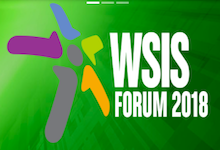Maximising impact for sustainable development: How core business activities can achieve a multiplier effect through equal opportunity sourcing from women owned businesses
19 Mar 2018 14:30h - 16:15h
Event report
[Read more session reports from the WSIS Forum 2018]
The workshop started with an introduction by moderator Ms Phillippa Biggs, senior policy analyst at the International Telecommunication Union (ITU), who explained that the aim was to explore whether best practices and existing initiatives have a greater impact on sustainable development through supplier diversity programmes.
The disproportionately low share of procurement contracts women-led businesses secure globally was underlined as an important issue despite the increasing number of governments and businesses who are realising the opportunity to contribute to sustainable development through introducing equal opportunity measures to their procurement programmes. Biggs cited a report on a survey carried out in 2014 under the World Bank’s programme on lending – the International Finance Corporation (IFC) – involving millions of small and medium enterprises (SMEs) in 140 countries which found that women-owned SMEs only received 14% of IFC’s lending portfolio in any given year. The picture became worse when it came to the credit gap for women-owned SMEs, which was estimated at 287 billion USD. Mori stressed that despite these numbers the IFC had identified social and cultural norms, for example, a tendency for women-owned SMEs to be smaller. Limited access to business education and networks were also primary challenges to women-owned businesses. Expressing doubts about solely depending on quotas, Mori stated the products and services provided by women-led businesses were good enough to compete with other businesses, and these quotas should be transitional measures at best.
Mr Andrea Fimian, EMEA Supplier Diversity Program manager at IBM Switzerland, took the floor to introduce IBM’s supplier diversity programme which was launched 50 years ago in the USA and had gone global in 2010. Fimian cited the reasons to have such a programme not only directed at women, but also at ethnic minorities, people with disabilities, and LGBT individuals, as a way of giving power back to these communities who own and control their own companies. He noted that SMEs are more flexible and innovative and have higher commitment compared to larger or global suppliers. Each of IBM’s tenders has to have at least one minority supplier, but once a business is on the tender they are competing under the same conditions as other potential suppliers.
Ms Anna Mori, from the Women and Trade Program at the International Trade Centre (ITC), mentioned how being online levels the playing field for women-owned businesses; while only 25% of strictly offline businesses are owned by women, this number doubles with e-commerce endeavours run by female entrepreneurs. Lack of digital skills and hardships in Internet access were underlined as barriers to e-commerce in developing countries although these barriers are not only faced by women-owned businesses but by all SMEs in these countries. The ITC collaborates with UPS and eBay to increase the digital and entrepreneurial skills of women and provide market access through the ITC She Trades initiative, which aims to connect one billion women to markets in 70 identified areas to lift barriers faced by them. The programme works not only with the private sector but also with governments to increase procurement from women-owned businesses.
Ms Christine Löw, director at the UN Women Liaison Office in Geneva, touched briefly on the policy perspective of the issue of UN Women’s efforts to support access to skills and markets and mentioned their guide ‘Gender Responsive Corporate Procurement’ created in collaboration with US-based We Connect. Providing a holistic framework for corporations and empowering and equipping women to become market players and change makers were two main points the project aimed for. She touched on the sustainable development goals (SDG) 5 targets and barriers directly and indirectly impacting on the business aspect, such as discriminatory laws, violence against women, roles in the family such as the unpaid care work that women do, full effect leadership, and participation of women. The major factors preventing women-owned businesses were cited as access to financial resources and social, human capital.
A participant from the GSMA talked about GSMA’s Connected Women initiative, where 26 operators in 34 countries have committed to closing the gender gap in their mobile operating and mobile money users.
The need to synchronise the various efforts working towards the same goals was underlined as an important concluding point.
By Su Sonia Herring
Related topics
Related event

